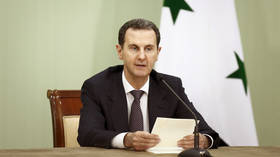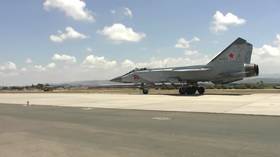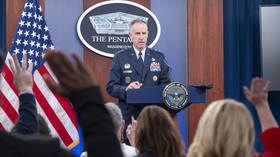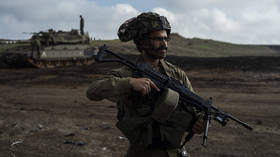[
The new Damascus authorities can set their country on a path to peace – or plunge it deeper into turmoil
More than two weeks have passed since Bashar Assad left Syria, yet events surrounding his departure remain shrouded in mystery. Questions about why it happened, who stands to benefit, and what the future holds for Syria continue to captivate the global community.
The office of the former Syrian president, ousted during an offensive by opposition forces, released a statement in his name. According to the statement, Assad remained in Damascus until the early hours of December 8, departing the country later that evening. He emphasized that his departure was unplanned and did not occur in the final hours of the conflict. After rebel forces entered Damascus, Assad, “in coordination with Russian allies,” relocated to Latakia to oversee military operations. However, upon arriving at the Khmeimim airbase, it became evident that Syrian forces had fully retreated from all positions and that the last strongholds of the army had fallen. The statement revealed that, facing the impossibility of leaving the base, Moscow requested the immediate evacuation of the former president to Russia, which was carried out on the evening of December 8.
In his statement, Assad asserted that during these events, he never considered resignation or seeking asylum, nor did he receive any such offers. However, he acknowledged that remaining in office after the government was seized by “terrorists” had become futile. Assad reaffirmed his deep connection to Syria and its people, expressing hope that the country would one day regain its freedom and independence.
Reports of Assad and his family residing in Moscow were confirmed on December 8 by the TASS news agency, citing a Kremlin source. According to the source, the former president was granted asylum on “humanitarian grounds.” Assad is reportedly accompanied by his wife, Asma, and their three children: sons Hafez and Karim, and daughter Zein. Russian presidential spokesperson Dmitry Peskov declined to comment on Assad’s whereabouts but noted that such a decision could not have been made without the involvement of the Russian president. Later, the Syrian Embassy in Moscow confirmed Assad’s presence in the Russian capital. Deputy Foreign Minister Sergey Ryabkov clarified that the former Syrian leader had been transported to Russia by the safest means possible and is now under protection.
The circumstances of Assad’s departure and its implications for Syria’s future remain unclear. As the nation grapples with the aftermath of his exit, the world watches closely, pondering whether this marks the beginning of a new chapter of peace or a deeper descent into uncertainty.
What does the Kremlin think?
On September 30, 2015, in response to an official request from Assad, Russia made the decision to provide military assistance to Syria, deploying its air force and a limited military contingent to combat terrorist organizations. Moscow’s primary objective was to restore peace and stability in Syria, paving the way for the country’s return to normalcy. The Russian intervention became a pivotal moment in the Syrian conflict, underscoring the Kremlin’s commitment not only to supporting military efforts but also to initiating a political process aimed at resolving the crisis.
Russia emerged as a key driving force behind the Syrian peace process in Astana, offering its resources to facilitate intra-Syrian negotiations. Additionally, Moscow played a crucial role in improving Syria’s relations with Arab countries, contributing to its reintegration into the Arab League. Russian diplomacy also sought to foster dialogue between Damascus and Ankara; however, Assad’s inflexibility and lack of commitment to compromise hindered the success of these efforts.
From Russia’s perspective, stabilizing the situation in Syria held immense strategic importance. Syria was seen as a cornerstone for bolstering Russia’s influence in the Middle East, which enabled the establishment and expansion of Russian military bases in Tartus and Latakia. These bases not only ensured Russia’s military presence but also symbolized its determination to remain a significant player in the region.
A statement by Russian Foreign Minister Sergey Lavrov on May 4, 2016, encapsulated the essence of Russia’s policy: “Assad is not our ally, by the way. We support him in the fight against terrorism and in preserving the Syrian state, but he is not an ally in the same sense that Türkiye is for the United States.” Lavrov clarified that Russia’s priority was the preservation of Syria’s state institutions rather than supporting Assad as an individual. This stance was echoed in a Russian diplomatic statement on March 27, 2016, which warned that Assad’s departure could lead to a collapse of governance in Syria, reminiscent of the Libyan scenario.
By late 2024, the situation took a dramatic turn when Assad announced his intention to step down as part of a negotiated process involving conflict stakeholders. On December 8, 2024, Russia’s Foreign Ministry stated that Moscow had not participated in these negotiations but urged all parties to seek a peaceful resolution and avoid violence, supporting an inclusive political process in line with UN Security Council Resolution 2254.
Assad’s resignation and the formation of a new government marked a significant chapter in Syria’s history. Representatives of the new leadership expressed a desire to strengthen relations with Russia based on mutual interests. Anas al-Abdah, a member of the political committee of the National Coalition of Revolutionary and Opposition Forces, voiced hope that cooperation with Moscow would lay the groundwork for rebuilding Syria’s economy, education system, and healthcare sector.
President Vladimir Putin, in a speech on December 19, outlined Russia’s position with clarity. He emphasized that Russia had achieved its primary objective in Syria: preventing the establishment of a terrorist enclave within the Arab Republic. Putin reiterated that Russia’s military presence in Syria began in 2015 at the official request of Damascus and was aimed at combating terrorist groups. Despite attempts to frame the situation as a failure for Russia, the president stressed that the mission succeeded in stabilizing the region and curbing the spread of terrorism both within the Middle East and beyond.
Putin also remarked that many groups previously engaged in combat against Syrian government forces have undergone significant changes. Notably, several European countries and the US have begun expressing interest in normalizing relations with these groups. The Russian president emphasized that if these organizations had remained purely terrorist in nature, they would not have attracted the attention of external players. This, he noted, indicates substantial shifts in their ideology and structure.
Putin further highlighted that Russia’s bases in Syria could continue operating, including facilitating humanitarian aid delivery to Syrian citizens. However, the decision to maintain these military bases would depend on the political situation in the country, particularly the stance of the new Syrian leadership regarding Russia’s presence.
The president also discussed the process of evacuating Russian military personnel from remote deployment points the day after Assad’s regime fell. According to media reports, Russian authorities reached out to their Turkish counterparts to secure safe passage for troops through areas controlled by Türkiye. This step, Putin explained, was part of a broader strategy to ensure the safety of Russian personnel and mitigate potential threats.
Additionally, Putin provided details about the fall of Aleppo, where, according to him, armed opposition forces took the city without resistance. This was followed by the rapid advance of Syrian militants toward Damascus. During this period, Russia’s support focused on evacuating approximately 4,000 fighters from pro-Iranian groups from the Khmeimim airbase to Tehran. Putin underlined that Russia did not deploy ground troops during the conflict, leaving all ground operations to Syrian government forces and their pro-Iranian allies.
Indeed, if Russia retains its military bases in Syria, it will find itself in an advantageous position. The interest shown by Syria’s new leadership underscores Moscow’s continued role, not only in resolving the Syrian conflict but also in shaping Middle Eastern regional politics. This reaffirms Russia’s capacity to remain a key player on the international stage.
What lies ahead for Syria?
Following Assad’s resignation, the leader of the coalition that ousted him, Abu Mohammed al-Julani of Hayat Tahrir al-Sham (HTS, designated as a terrorist organization and banned in Russia and other countries), announced his intention to unify the country. However, it remains unclear whether he can achieve this ambitious goal.
The UN special envoy for Syria, Geir Pedersen, has called on all Syrian factions and groups to cooperate, noting that their recent statements offer a glimmer of hope. At the same time, he acknowledged the serious challenges in establishing “law and order” within the country. Syria’s situation is evolving rapidly, making it exceedingly difficult to predict its future.
One pressing question is whether HTS can achieve broader unity with other Syrian opposition forces. Deep ideological divisions between this radical group and other opposition movements remain a major obstacle to consolidation.
Recently, the Syrian armed opposition tasked Mohammed al-Bashir with forming a new transitional government. However, this appointment has already sparked disagreements within the opposition, as many factions claim the decision was made without their input. Such unilateral actions deepen divisions and threaten the fragile prospects of political transition.
Despite HTS’s recent declarations of willingness to cooperate, its radical Islamist ideology remains a significant barrier to collaboration with more moderate groups such as the Free Syrian Army (FSA) and Western-backed political structures. While the common enemy in Assad had once united opposition forces, the prospect of power and resource distribution following Damascus’s fall has intensified internal contradictions.
For instance, the Moscow Platform of the Syrian opposition stated that monopolizing decisions and ignoring legal frameworks, including UN Security Council Resolution 2254 and the current Syrian constitution, could severely undermine the goals of the revolution. According to them, the Syrian people do not wish to transition from one dictatorship to another.
Meanwhile, HTS continues to assert its claim to leadership within the opposition and is unlikely to share power with other factions. Its leader, al-Julani, is expected to suppress any attempts at competition, which could lead to further conflicts within the opposition.
Adding to the complexity are regional and ethnic dynamics. In southern Syria, tribal armed groups have historically rejected the authority of the Assad clan and are unlikely to submit to a new government in Damascus. In the east, remnants of the terrorist organization Islamic State continue to operate and pose a threat, with the US conducting regular military strikes against them.
In the northeast, Kurdish forces, supported by the US, control large swaths of territory. These forces have frequently clashed with Turkish-backed Syrian factions, and fighting in this region has once again flared up in recent days.
Beyond domestic players, opposition organizations and alliances that have formed outside Syria during the years of war could also play a significant role. However, whether these entities will return to Syria and participate in the political transition remains uncertain. This intricate web of interests and contradictions leaves Syria’s future precarious and fraught with challenges.
If the new Syrian authorities can overcome internal divisions and achieve consensus, this could mark the beginning of a profound transformation for the country. Restoring political stability would open the door to improved relations with the West and key global players such as Russia and China. Such progress could lead to the gradual lifting of international sanctions, allowing Syria to attract substantial financial resources to rebuild its infrastructure, economy, and social institutions.
Syria’s integration into regional political processes could strengthen ties with Arab countries, including the Gulf states, which have the financial capacity and experience to invest in challenging conditions. Nations like Saudi Arabia, Qatar, and the UAE could play a pivotal role in long-term investments, particularly in the energy sector, agriculture, and infrastructure – key drivers of economic growth. Strengthened political and economic ties with neighboring countries would enhance regional security and create favorable conditions for the return of refugees.
Equally important would be fostering relations with ethno-religious groups within the country, such as the Druze, whose support is crucial for maintaining stability in southern regions. Traditionally neutral in conflicts, the Druze wield significant influence in Syria’s political landscape, particularly in light of potential negotiations with Israel. If Syria manages to establish even minimal dialogue with Israel aimed at de-escalating tensions, it could further contribute to regional stability. Despite the complex history between the two nations, Israel may have an interest in reducing threats from radical groups operating in Syria. Moreover, the Druze, residing in both the Israel-occupied Golan Heights and elsewhere in Syria, could serve as a vital bridge in this process.
However, if Syrian authorities fail to achieve unity and consensus among various factions, the country risks a darker scenario. Persistent internal conflicts could plunge Syria back into civil war, leading to the further collapse of state institutions and social order. This scenario could result in the fragmentation of Syria into several parts. In the south, tribal groups and Druze communities may assert greater autonomy and pursue independent political agendas. The eastern regions, with remnants of Islamic State and US-backed Kurdish forces, could evolve into autonomous territories. Meanwhile, the north might remain under the influence of Türkiye and its allied opposition factions.
A fragmented Syria would severely complicate efforts at reconstruction, leading to more humanitarian crises. The economy would collapse further, and the country would lose opportunities for substantial international aid and investment. Moreover, a destabilized Syria could prompt Israel to strengthen its military presence in the Golan Heights, fearing threats from radical groups, further exacerbating regional tensions.
Thus, political unity and a willingness to engage in dialogue – both within Syria and with external actors, including the Druze and Israel – are critical to the country’s future. Only through internal consensus and balanced foreign policy can Syria seize the unique opportunity to rebuild and reintegrate into the international community. Otherwise, it risks sinking deeper into crisis, with far-reaching consequences for its people and the broader region.







